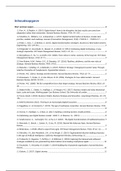Samenvatting
Digital transformation and strategic innovation - short summary papers
Short summary papers 3 1.1 Furr, N., & Shipilov, A. (2019). Digital doesn’t have to be disruptive: the best results can come from adaptation rather than reinvention. Harvard Business Review, 97(4): 94- 103. 3 1.2 Schallmo, D., Williams, C.A., & Boardman, L. (2017). Digital transformation of busin...
[Meer zien]




